Diabetes in India: A Systematic Review of Health Promotion Strategies
VerifiedAdded on 2023/06/07
|9
|1984
|51
Report
AI Summary
This report provides a systematic review of the increasing prevalence of diabetes in India, examining the factors contributing to its rise and potential health promotion strategies for prevention and management. The review highlights the importance of education, awareness, and government initiatives in addressing the growing number of diabetes cases. It also emphasizes the need for further research to identify effective measures for reducing the burden of diabetes in India, considering the impact of lifestyle changes, socioeconomic factors, and healthcare access. The document is available on Desklib, a platform providing study tools and assignments for students.
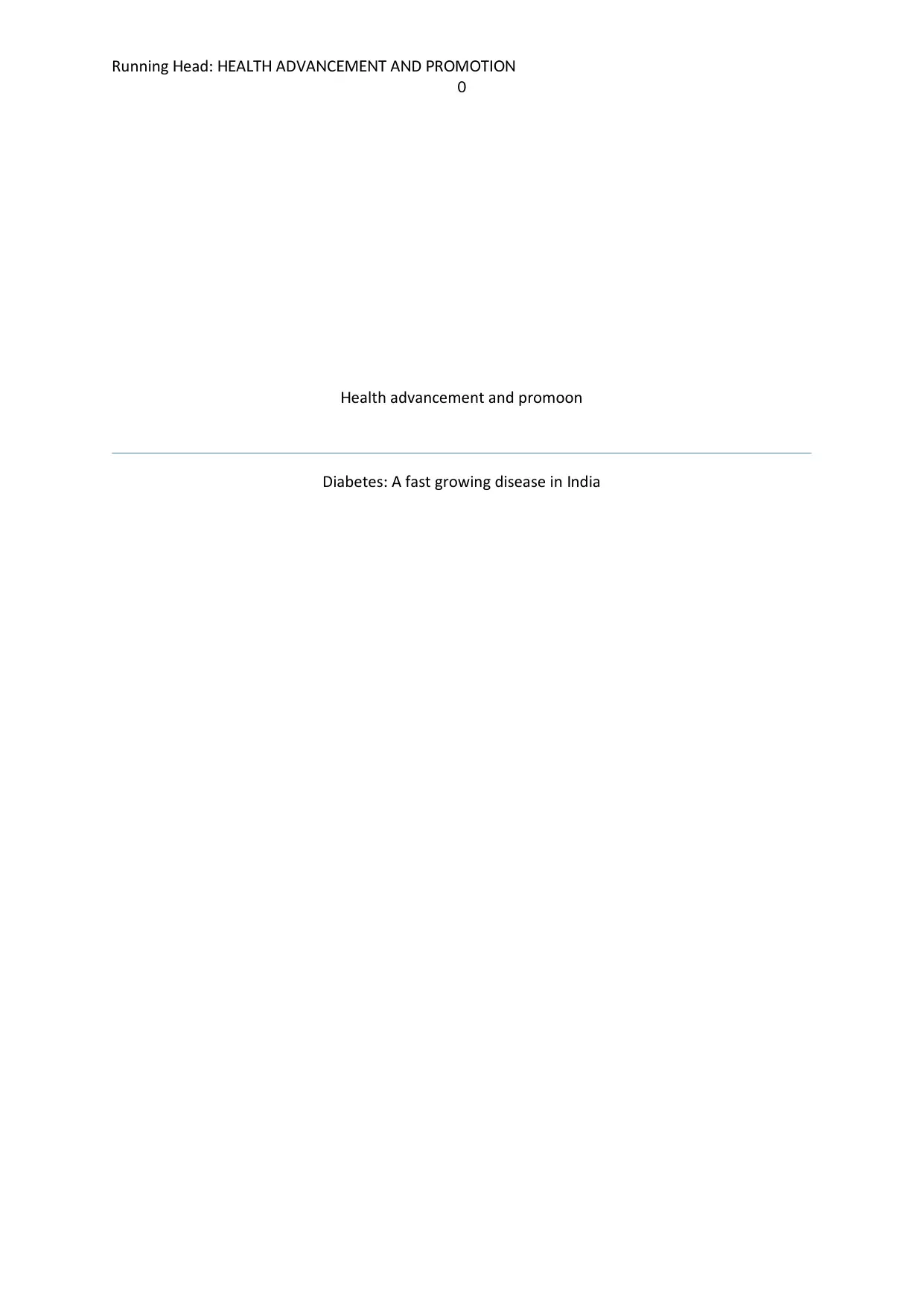
Running ead A ADVA C M A D R MH : HE LTH N E ENT N P O OTION
0
ealth advancement and promotionH
Diabetes A fast growing disease in ndia: I
0
ealth advancement and promotionH
Diabetes A fast growing disease in ndia: I
Paraphrase This Document
Need a fresh take? Get an instant paraphrase of this document with our AI Paraphraser
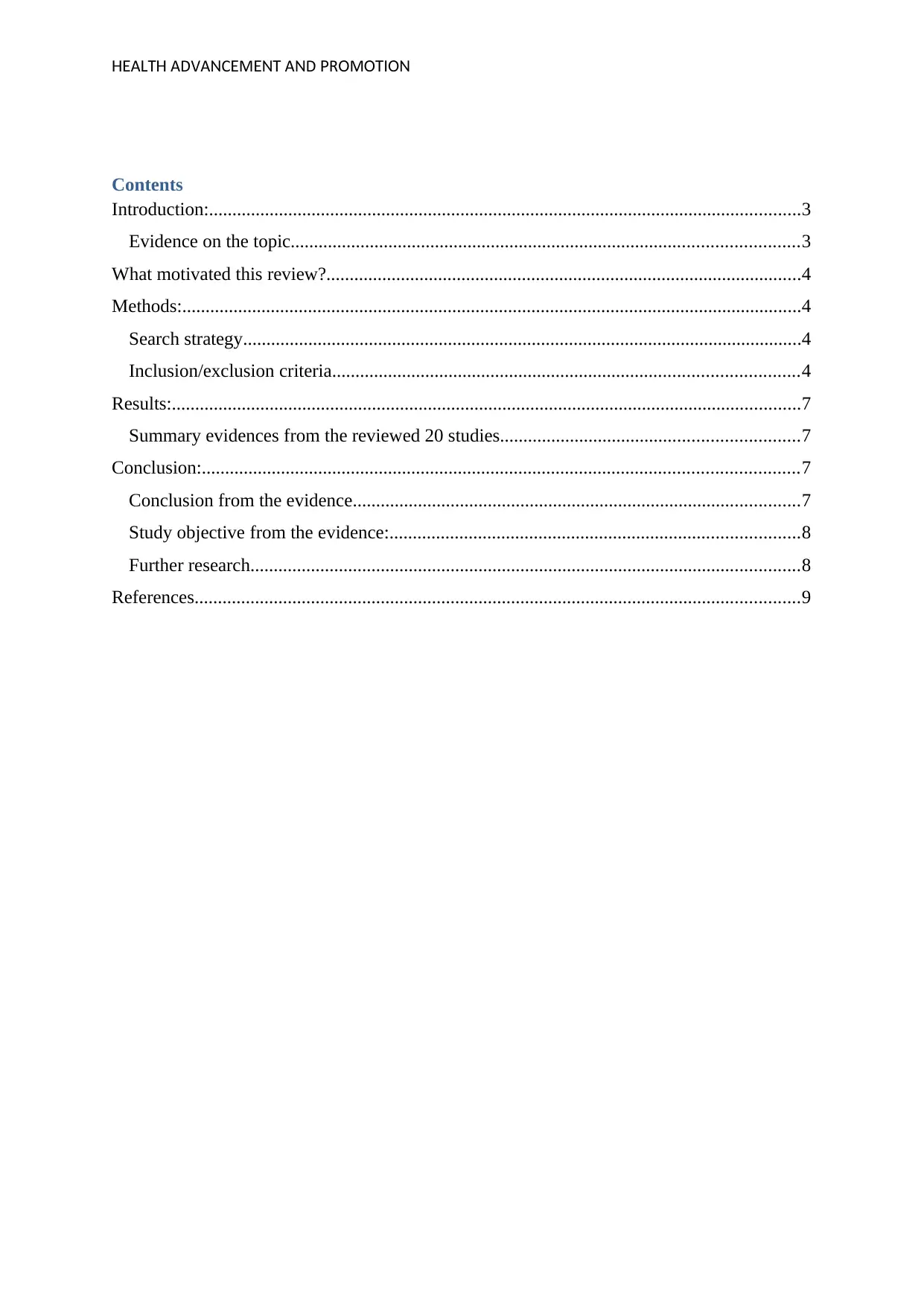
A ADVA C M A D R MHE LTH N E ENT N P O OTION
Contents
Introduction:...............................................................................................................................3
Evidence on the topic.............................................................................................................3
What motivated this review?......................................................................................................4
Methods:.....................................................................................................................................4
Search strategy........................................................................................................................4
Inclusion/exclusion criteria....................................................................................................4
Results:.......................................................................................................................................7
Summary evidences from the reviewed 20 studies................................................................7
Conclusion:................................................................................................................................7
Conclusion from the evidence................................................................................................7
Study objective from the evidence:........................................................................................8
Further research......................................................................................................................8
References..................................................................................................................................9
Contents
Introduction:...............................................................................................................................3
Evidence on the topic.............................................................................................................3
What motivated this review?......................................................................................................4
Methods:.....................................................................................................................................4
Search strategy........................................................................................................................4
Inclusion/exclusion criteria....................................................................................................4
Results:.......................................................................................................................................7
Summary evidences from the reviewed 20 studies................................................................7
Conclusion:................................................................................................................................7
Conclusion from the evidence................................................................................................7
Study objective from the evidence:........................................................................................8
Further research......................................................................................................................8
References..................................................................................................................................9
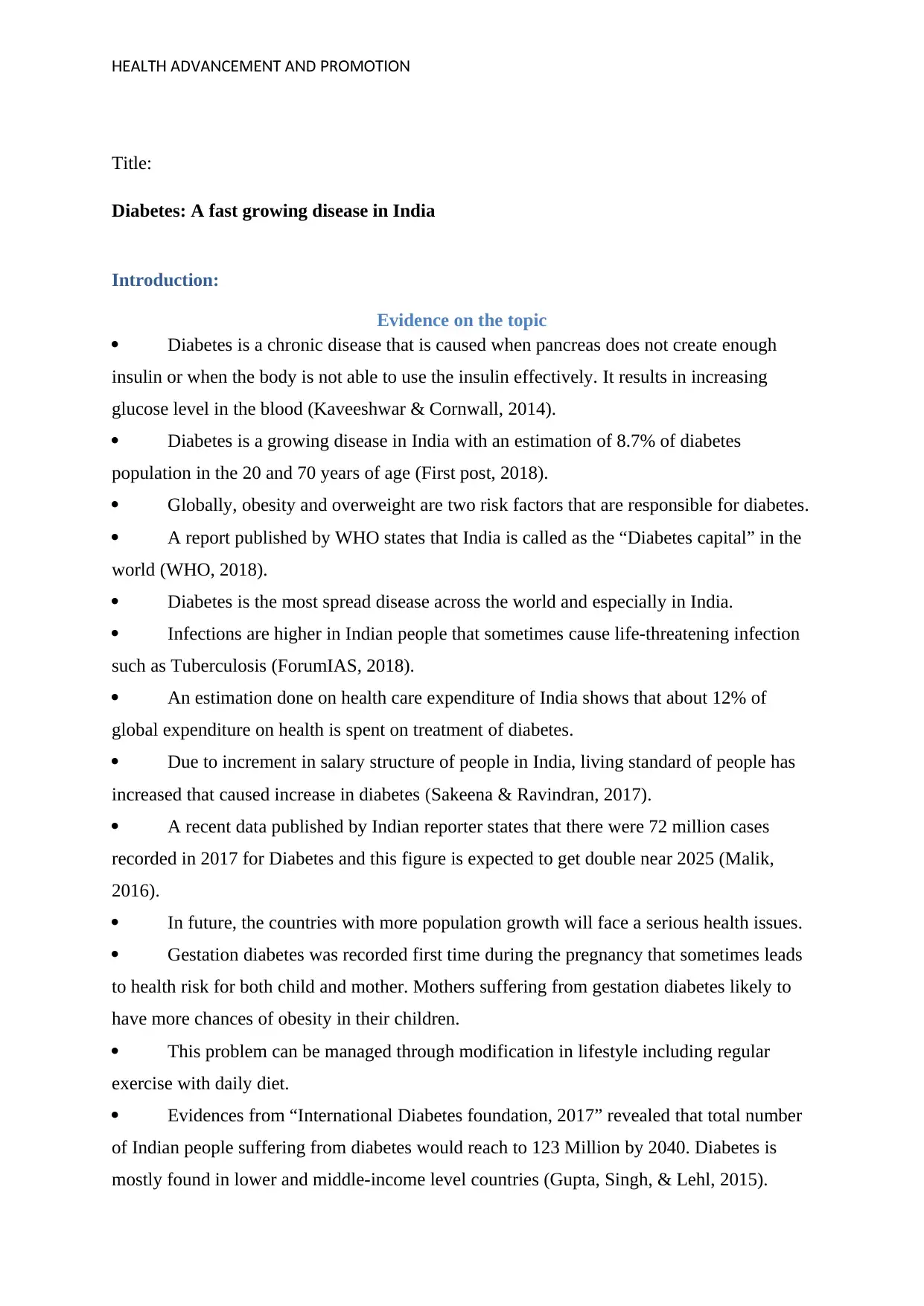
A ADVA C M A D R MHE LTH N E ENT N P O OTION
Title:
Diabetes: A fast growing disease in India
Introduction:
Evidence on the topic
Diabetes is a chronic disease that is caused when pancreas does not create enough
insulin or when the body is not able to use the insulin effectively. It results in increasing
glucose level in the blood (Kaveeshwar & Cornwall, 2014).
Diabetes is a growing disease in India with an estimation of 8.7% of diabetes
population in the 20 and 70 years of age (First post, 2018).
Globally, obesity and overweight are two risk factors that are responsible for diabetes.
A report published by WHO states that India is called as the “Diabetes capital” in the
world (WHO, 2018).
Diabetes is the most spread disease across the world and especially in India.
Infections are higher in Indian people that sometimes cause life-threatening infection
such as Tuberculosis (ForumIAS, 2018).
An estimation done on health care expenditure of India shows that about 12% of
global expenditure on health is spent on treatment of diabetes.
Due to increment in salary structure of people in India, living standard of people has
increased that caused increase in diabetes (Sakeena & Ravindran, 2017).
A recent data published by Indian reporter states that there were 72 million cases
recorded in 2017 for Diabetes and this figure is expected to get double near 2025 (Malik,
2016).
In future, the countries with more population growth will face a serious health issues.
Gestation diabetes was recorded first time during the pregnancy that sometimes leads
to health risk for both child and mother. Mothers suffering from gestation diabetes likely to
have more chances of obesity in their children.
This problem can be managed through modification in lifestyle including regular
exercise with daily diet.
Evidences from “International Diabetes foundation, 2017” revealed that total number
of Indian people suffering from diabetes would reach to 123 Million by 2040. Diabetes is
mostly found in lower and middle-income level countries (Gupta, Singh, & Lehl, 2015).
Title:
Diabetes: A fast growing disease in India
Introduction:
Evidence on the topic
Diabetes is a chronic disease that is caused when pancreas does not create enough
insulin or when the body is not able to use the insulin effectively. It results in increasing
glucose level in the blood (Kaveeshwar & Cornwall, 2014).
Diabetes is a growing disease in India with an estimation of 8.7% of diabetes
population in the 20 and 70 years of age (First post, 2018).
Globally, obesity and overweight are two risk factors that are responsible for diabetes.
A report published by WHO states that India is called as the “Diabetes capital” in the
world (WHO, 2018).
Diabetes is the most spread disease across the world and especially in India.
Infections are higher in Indian people that sometimes cause life-threatening infection
such as Tuberculosis (ForumIAS, 2018).
An estimation done on health care expenditure of India shows that about 12% of
global expenditure on health is spent on treatment of diabetes.
Due to increment in salary structure of people in India, living standard of people has
increased that caused increase in diabetes (Sakeena & Ravindran, 2017).
A recent data published by Indian reporter states that there were 72 million cases
recorded in 2017 for Diabetes and this figure is expected to get double near 2025 (Malik,
2016).
In future, the countries with more population growth will face a serious health issues.
Gestation diabetes was recorded first time during the pregnancy that sometimes leads
to health risk for both child and mother. Mothers suffering from gestation diabetes likely to
have more chances of obesity in their children.
This problem can be managed through modification in lifestyle including regular
exercise with daily diet.
Evidences from “International Diabetes foundation, 2017” revealed that total number
of Indian people suffering from diabetes would reach to 123 Million by 2040. Diabetes is
mostly found in lower and middle-income level countries (Gupta, Singh, & Lehl, 2015).
⊘ This is a preview!⊘
Do you want full access?
Subscribe today to unlock all pages.

Trusted by 1+ million students worldwide
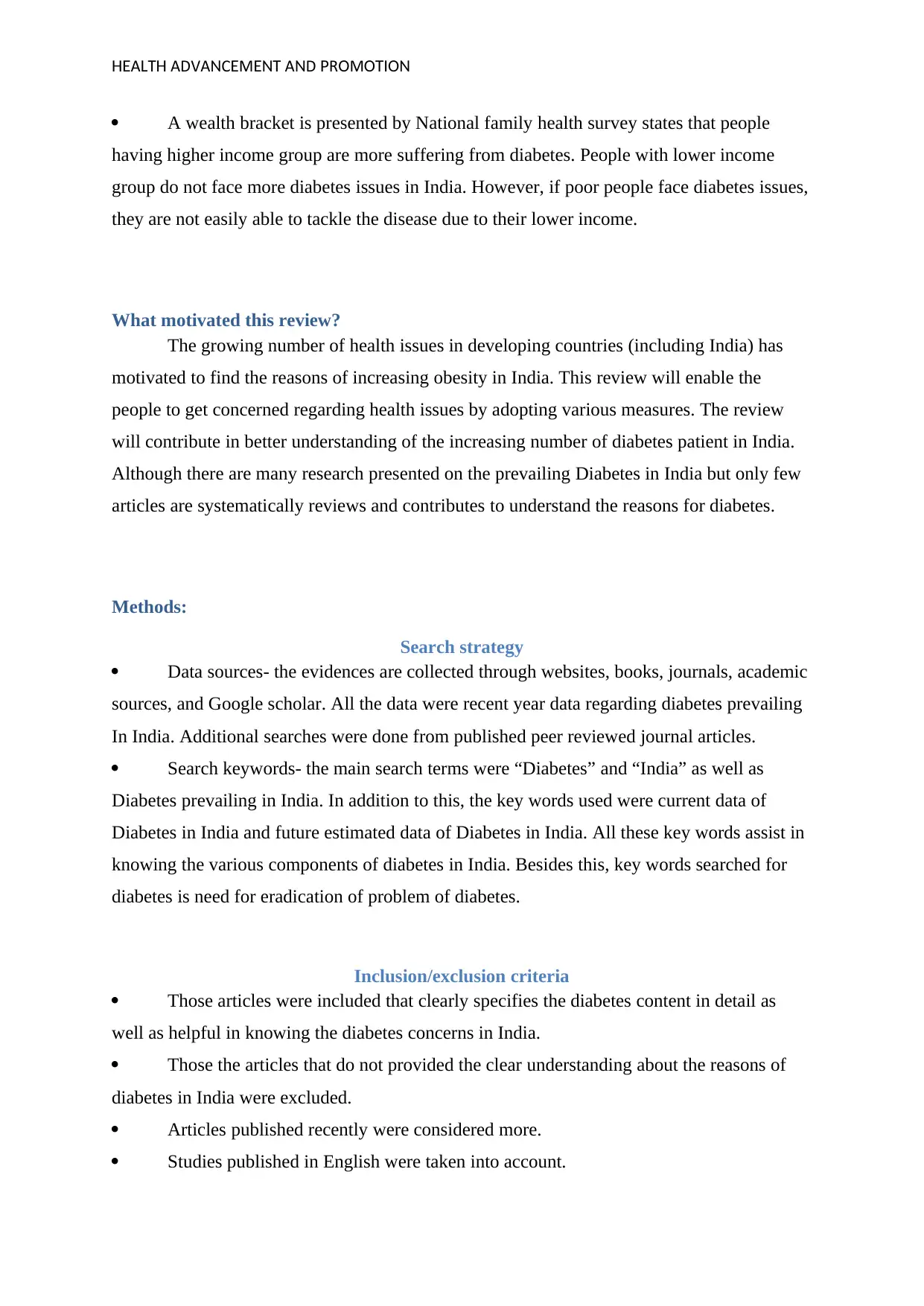
A ADVA C M A D R MHE LTH N E ENT N P O OTION
A wealth bracket is presented by National family health survey states that people
having higher income group are more suffering from diabetes. People with lower income
group do not face more diabetes issues in India. However, if poor people face diabetes issues,
they are not easily able to tackle the disease due to their lower income.
What motivated this review?
The growing number of health issues in developing countries (including India) has
motivated to find the reasons of increasing obesity in India. This review will enable the
people to get concerned regarding health issues by adopting various measures. The review
will contribute in better understanding of the increasing number of diabetes patient in India.
Although there are many research presented on the prevailing Diabetes in India but only few
articles are systematically reviews and contributes to understand the reasons for diabetes.
Methods:
Search strategy
Data sources- the evidences are collected through websites, books, journals, academic
sources, and Google scholar. All the data were recent year data regarding diabetes prevailing
In India. Additional searches were done from published peer reviewed journal articles.
Search keywords- the main search terms were “Diabetes” and “India” as well as
Diabetes prevailing in India. In addition to this, the key words used were current data of
Diabetes in India and future estimated data of Diabetes in India. All these key words assist in
knowing the various components of diabetes in India. Besides this, key words searched for
diabetes is need for eradication of problem of diabetes.
Inclusion/exclusion criteria
Those articles were included that clearly specifies the diabetes content in detail as
well as helpful in knowing the diabetes concerns in India.
Those the articles that do not provided the clear understanding about the reasons of
diabetes in India were excluded.
Articles published recently were considered more.
Studies published in English were taken into account.
A wealth bracket is presented by National family health survey states that people
having higher income group are more suffering from diabetes. People with lower income
group do not face more diabetes issues in India. However, if poor people face diabetes issues,
they are not easily able to tackle the disease due to their lower income.
What motivated this review?
The growing number of health issues in developing countries (including India) has
motivated to find the reasons of increasing obesity in India. This review will enable the
people to get concerned regarding health issues by adopting various measures. The review
will contribute in better understanding of the increasing number of diabetes patient in India.
Although there are many research presented on the prevailing Diabetes in India but only few
articles are systematically reviews and contributes to understand the reasons for diabetes.
Methods:
Search strategy
Data sources- the evidences are collected through websites, books, journals, academic
sources, and Google scholar. All the data were recent year data regarding diabetes prevailing
In India. Additional searches were done from published peer reviewed journal articles.
Search keywords- the main search terms were “Diabetes” and “India” as well as
Diabetes prevailing in India. In addition to this, the key words used were current data of
Diabetes in India and future estimated data of Diabetes in India. All these key words assist in
knowing the various components of diabetes in India. Besides this, key words searched for
diabetes is need for eradication of problem of diabetes.
Inclusion/exclusion criteria
Those articles were included that clearly specifies the diabetes content in detail as
well as helpful in knowing the diabetes concerns in India.
Those the articles that do not provided the clear understanding about the reasons of
diabetes in India were excluded.
Articles published recently were considered more.
Studies published in English were taken into account.
Paraphrase This Document
Need a fresh take? Get an instant paraphrase of this document with our AI Paraphraser
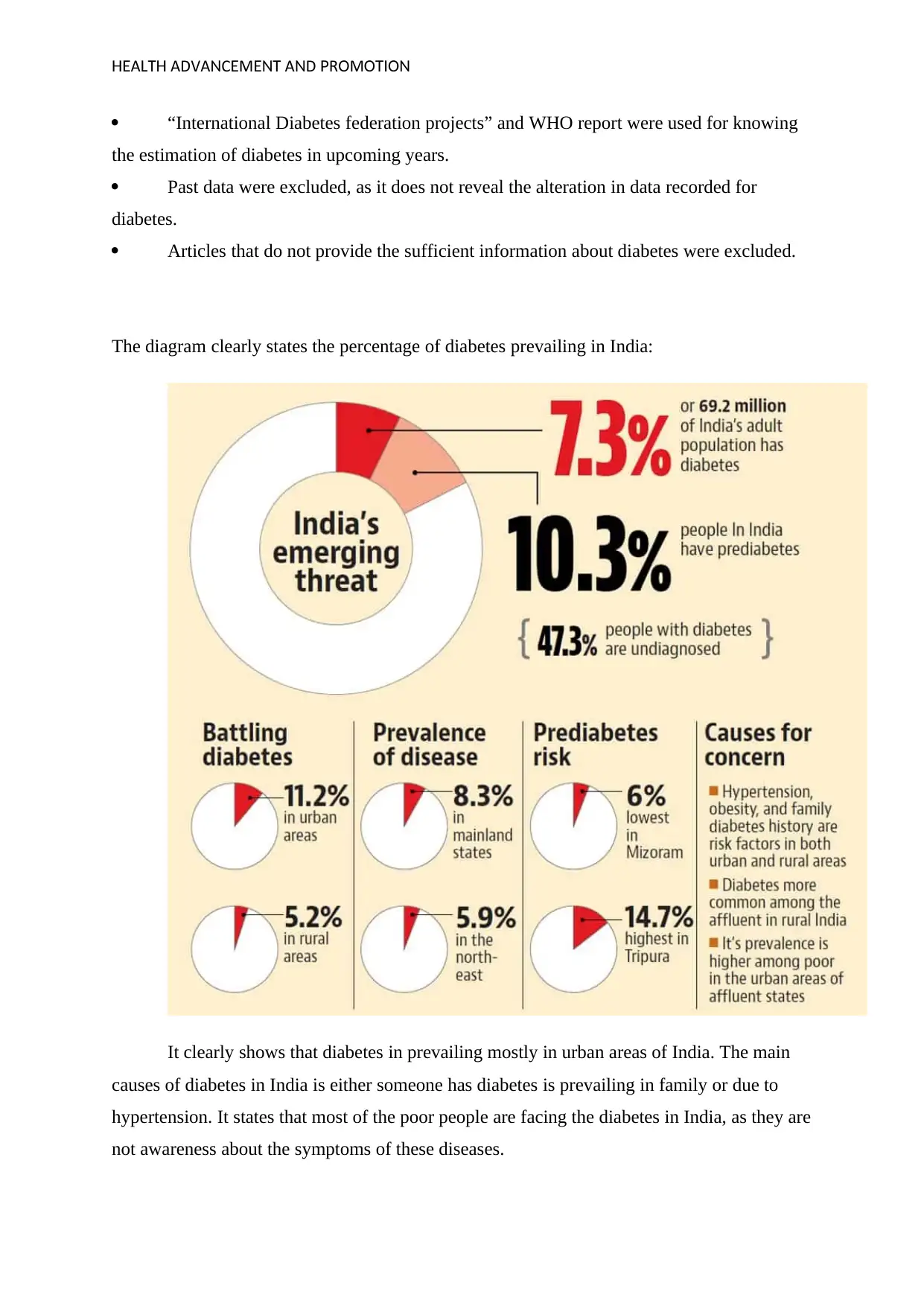
A ADVA C M A D R MHE LTH N E ENT N P O OTION
“International Diabetes federation projects” and WHO report were used for knowing
the estimation of diabetes in upcoming years.
Past data were excluded, as it does not reveal the alteration in data recorded for
diabetes.
Articles that do not provide the sufficient information about diabetes were excluded.
The diagram clearly states the percentage of diabetes prevailing in India:
It clearly shows that diabetes in prevailing mostly in urban areas of India. The main
causes of diabetes in India is either someone has diabetes is prevailing in family or due to
hypertension. It states that most of the poor people are facing the diabetes in India, as they are
not awareness about the symptoms of these diseases.
“International Diabetes federation projects” and WHO report were used for knowing
the estimation of diabetes in upcoming years.
Past data were excluded, as it does not reveal the alteration in data recorded for
diabetes.
Articles that do not provide the sufficient information about diabetes were excluded.
The diagram clearly states the percentage of diabetes prevailing in India:
It clearly shows that diabetes in prevailing mostly in urban areas of India. The main
causes of diabetes in India is either someone has diabetes is prevailing in family or due to
hypertension. It states that most of the poor people are facing the diabetes in India, as they are
not awareness about the symptoms of these diseases.
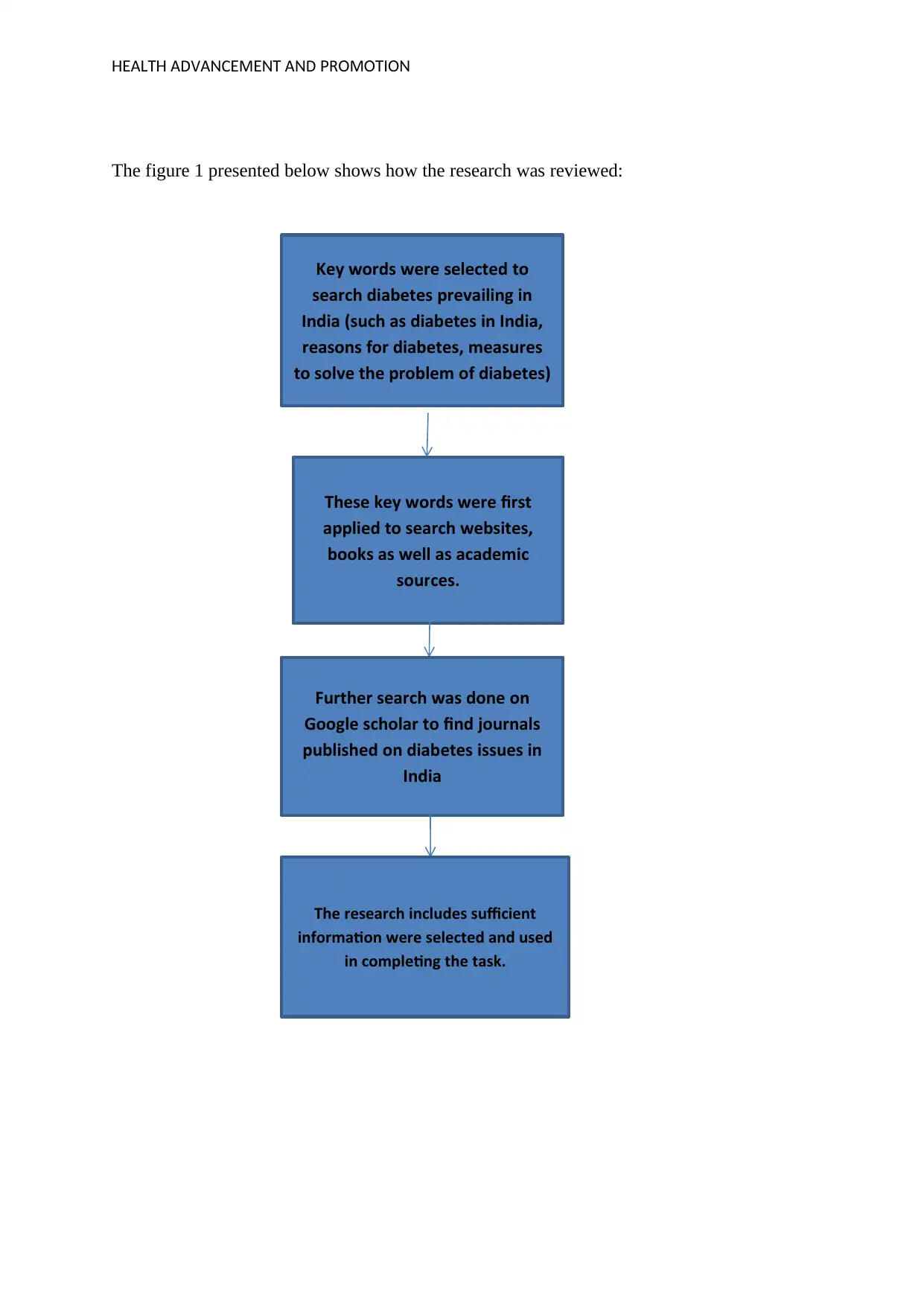
A ADVA C M A D R MHE LTH N E ENT N P O OTION
The figure 1 presented below shows how the research was reviewed:
Key words were selected to
search diabetes prevailing in
India (such as diabetes in India,
reasons for diabetes, measures
to solve the problem of diabetes)
These key words were first
applied to search websites,
books as well as academic
sources.
Further search was done on
Google scholar to find journals
published on diabetes issues in
India
The research includes sufficient
information were selected and used
in completing the task.
The figure 1 presented below shows how the research was reviewed:
Key words were selected to
search diabetes prevailing in
India (such as diabetes in India,
reasons for diabetes, measures
to solve the problem of diabetes)
These key words were first
applied to search websites,
books as well as academic
sources.
Further search was done on
Google scholar to find journals
published on diabetes issues in
India
The research includes sufficient
information were selected and used
in completing the task.
⊘ This is a preview!⊘
Do you want full access?
Subscribe today to unlock all pages.

Trusted by 1+ million students worldwide
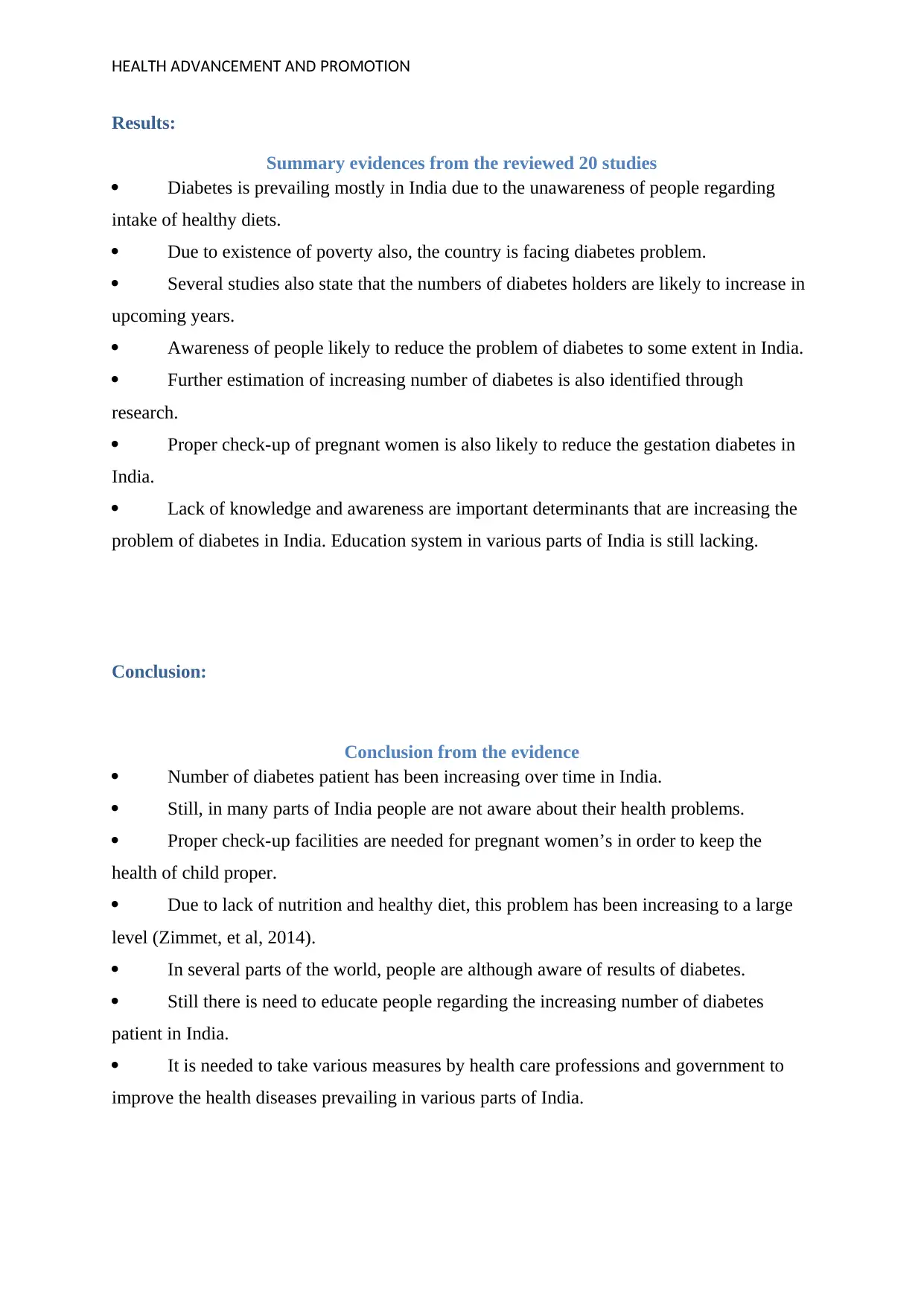
A ADVA C M A D R MHE LTH N E ENT N P O OTION
Results:
Summary evidences from the reviewed 20 studies
Diabetes is prevailing mostly in India due to the unawareness of people regarding
intake of healthy diets.
Due to existence of poverty also, the country is facing diabetes problem.
Several studies also state that the numbers of diabetes holders are likely to increase in
upcoming years.
Awareness of people likely to reduce the problem of diabetes to some extent in India.
Further estimation of increasing number of diabetes is also identified through
research.
Proper check-up of pregnant women is also likely to reduce the gestation diabetes in
India.
Lack of knowledge and awareness are important determinants that are increasing the
problem of diabetes in India. Education system in various parts of India is still lacking.
Conclusion:
Conclusion from the evidence
Number of diabetes patient has been increasing over time in India.
Still, in many parts of India people are not aware about their health problems.
Proper check-up facilities are needed for pregnant women’s in order to keep the
health of child proper.
Due to lack of nutrition and healthy diet, this problem has been increasing to a large
level (Zimmet, et al, 2014).
In several parts of the world, people are although aware of results of diabetes.
Still there is need to educate people regarding the increasing number of diabetes
patient in India.
It is needed to take various measures by health care professions and government to
improve the health diseases prevailing in various parts of India.
Results:
Summary evidences from the reviewed 20 studies
Diabetes is prevailing mostly in India due to the unawareness of people regarding
intake of healthy diets.
Due to existence of poverty also, the country is facing diabetes problem.
Several studies also state that the numbers of diabetes holders are likely to increase in
upcoming years.
Awareness of people likely to reduce the problem of diabetes to some extent in India.
Further estimation of increasing number of diabetes is also identified through
research.
Proper check-up of pregnant women is also likely to reduce the gestation diabetes in
India.
Lack of knowledge and awareness are important determinants that are increasing the
problem of diabetes in India. Education system in various parts of India is still lacking.
Conclusion:
Conclusion from the evidence
Number of diabetes patient has been increasing over time in India.
Still, in many parts of India people are not aware about their health problems.
Proper check-up facilities are needed for pregnant women’s in order to keep the
health of child proper.
Due to lack of nutrition and healthy diet, this problem has been increasing to a large
level (Zimmet, et al, 2014).
In several parts of the world, people are although aware of results of diabetes.
Still there is need to educate people regarding the increasing number of diabetes
patient in India.
It is needed to take various measures by health care professions and government to
improve the health diseases prevailing in various parts of India.
Paraphrase This Document
Need a fresh take? Get an instant paraphrase of this document with our AI Paraphraser
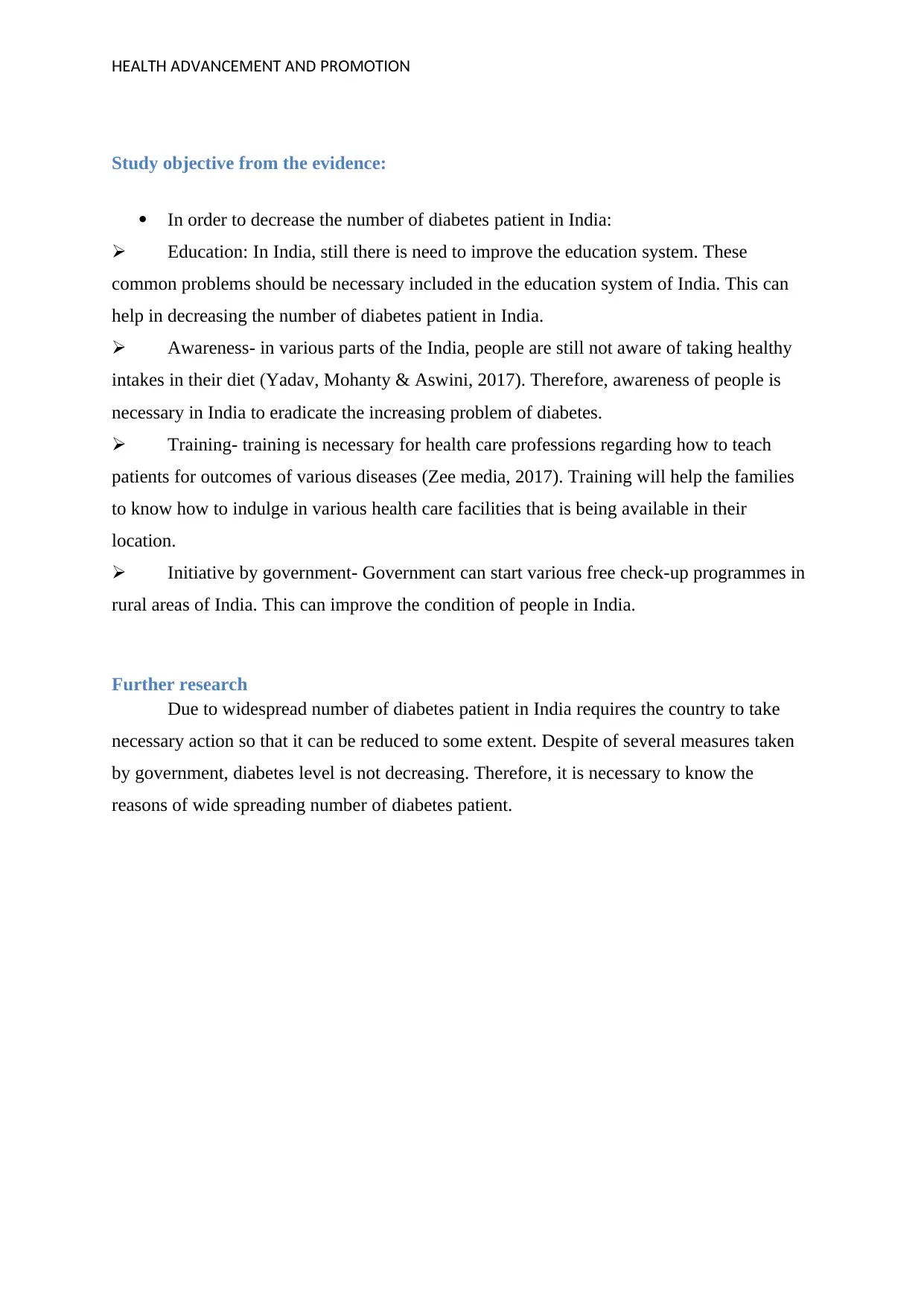
A ADVA C M A D R MHE LTH N E ENT N P O OTION
Study objective from the evidence:
In order to decrease the number of diabetes patient in India:
Education: In India, still there is need to improve the education system. These
common problems should be necessary included in the education system of India. This can
help in decreasing the number of diabetes patient in India.
Awareness- in various parts of the India, people are still not aware of taking healthy
intakes in their diet (Yadav, Mohanty & Aswini, 2017). Therefore, awareness of people is
necessary in India to eradicate the increasing problem of diabetes.
Training- training is necessary for health care professions regarding how to teach
patients for outcomes of various diseases (Zee media, 2017). Training will help the families
to know how to indulge in various health care facilities that is being available in their
location.
Initiative by government- Government can start various free check-up programmes in
rural areas of India. This can improve the condition of people in India.
Further research
Due to widespread number of diabetes patient in India requires the country to take
necessary action so that it can be reduced to some extent. Despite of several measures taken
by government, diabetes level is not decreasing. Therefore, it is necessary to know the
reasons of wide spreading number of diabetes patient.
Study objective from the evidence:
In order to decrease the number of diabetes patient in India:
Education: In India, still there is need to improve the education system. These
common problems should be necessary included in the education system of India. This can
help in decreasing the number of diabetes patient in India.
Awareness- in various parts of the India, people are still not aware of taking healthy
intakes in their diet (Yadav, Mohanty & Aswini, 2017). Therefore, awareness of people is
necessary in India to eradicate the increasing problem of diabetes.
Training- training is necessary for health care professions regarding how to teach
patients for outcomes of various diseases (Zee media, 2017). Training will help the families
to know how to indulge in various health care facilities that is being available in their
location.
Initiative by government- Government can start various free check-up programmes in
rural areas of India. This can improve the condition of people in India.
Further research
Due to widespread number of diabetes patient in India requires the country to take
necessary action so that it can be reduced to some extent. Despite of several measures taken
by government, diabetes level is not decreasing. Therefore, it is necessary to know the
reasons of wide spreading number of diabetes patient.
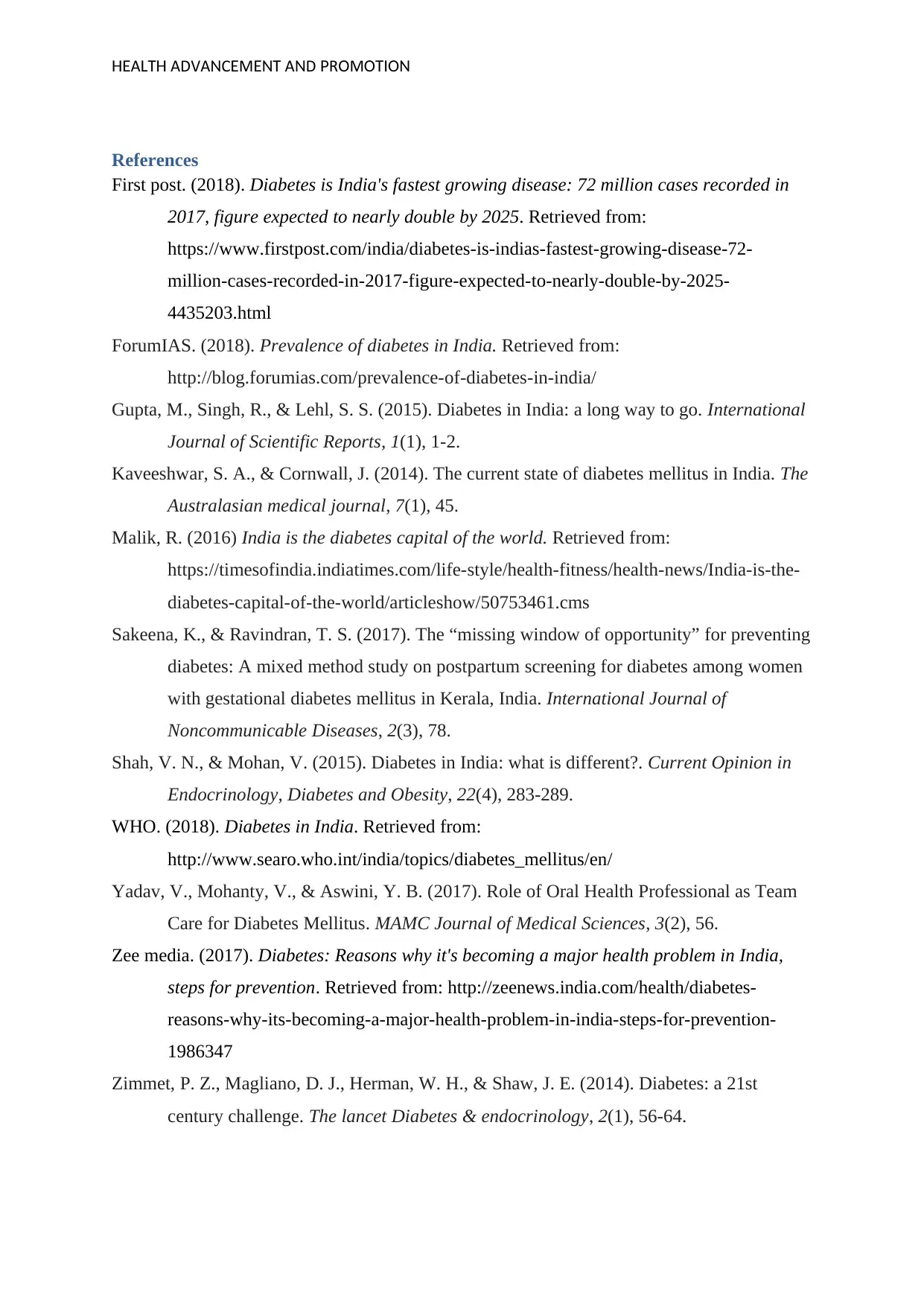
A ADVA C M A D R MHE LTH N E ENT N P O OTION
References
First post. (2018). Diabetes is India's fastest growing disease: 72 million cases recorded in
2017, figure expected to nearly double by 2025. Retrieved from:
https://www.firstpost.com/india/diabetes-is-indias-fastest-growing-disease-72-
million-cases-recorded-in-2017-figure-expected-to-nearly-double-by-2025-
4435203.html
ForumIAS. (2018). Prevalence of diabetes in India. Retrieved from:
http://blog.forumias.com/prevalence-of-diabetes-in-india/
Gupta, M., Singh, R., & Lehl, S. S. (2015). Diabetes in India: a long way to go. International
Journal of Scientific Reports, 1(1), 1-2.
Kaveeshwar, S. A., & Cornwall, J. (2014). The current state of diabetes mellitus in India. The
Australasian medical journal, 7(1), 45.
Malik, R. (2016) India is the diabetes capital of the world. Retrieved from:
https://timesofindia.indiatimes.com/life-style/health-fitness/health-news/India-is-the-
diabetes-capital-of-the-world/articleshow/50753461.cms
Sakeena, K., & Ravindran, T. S. (2017). The “missing window of opportunity” for preventing
diabetes: A mixed method study on postpartum screening for diabetes among women
with gestational diabetes mellitus in Kerala, India. International Journal of
Noncommunicable Diseases, 2(3), 78.
Shah, V. N., & Mohan, V. (2015). Diabetes in India: what is different?. Current Opinion in
Endocrinology, Diabetes and Obesity, 22(4), 283-289.
WHO. (2018). Diabetes in India. Retrieved from:
http://www.searo.who.int/india/topics/diabetes_mellitus/en/
Yadav, V., Mohanty, V., & Aswini, Y. B. (2017). Role of Oral Health Professional as Team
Care for Diabetes Mellitus. MAMC Journal of Medical Sciences, 3(2), 56.
Zee media. (2017). Diabetes: Reasons why it's becoming a major health problem in India,
steps for prevention. Retrieved from: http://zeenews.india.com/health/diabetes-
reasons-why-its-becoming-a-major-health-problem-in-india-steps-for-prevention-
1986347
Zimmet, P. Z., Magliano, D. J., Herman, W. H., & Shaw, J. E. (2014). Diabetes: a 21st
century challenge. The lancet Diabetes & endocrinology, 2(1), 56-64.
References
First post. (2018). Diabetes is India's fastest growing disease: 72 million cases recorded in
2017, figure expected to nearly double by 2025. Retrieved from:
https://www.firstpost.com/india/diabetes-is-indias-fastest-growing-disease-72-
million-cases-recorded-in-2017-figure-expected-to-nearly-double-by-2025-
4435203.html
ForumIAS. (2018). Prevalence of diabetes in India. Retrieved from:
http://blog.forumias.com/prevalence-of-diabetes-in-india/
Gupta, M., Singh, R., & Lehl, S. S. (2015). Diabetes in India: a long way to go. International
Journal of Scientific Reports, 1(1), 1-2.
Kaveeshwar, S. A., & Cornwall, J. (2014). The current state of diabetes mellitus in India. The
Australasian medical journal, 7(1), 45.
Malik, R. (2016) India is the diabetes capital of the world. Retrieved from:
https://timesofindia.indiatimes.com/life-style/health-fitness/health-news/India-is-the-
diabetes-capital-of-the-world/articleshow/50753461.cms
Sakeena, K., & Ravindran, T. S. (2017). The “missing window of opportunity” for preventing
diabetes: A mixed method study on postpartum screening for diabetes among women
with gestational diabetes mellitus in Kerala, India. International Journal of
Noncommunicable Diseases, 2(3), 78.
Shah, V. N., & Mohan, V. (2015). Diabetes in India: what is different?. Current Opinion in
Endocrinology, Diabetes and Obesity, 22(4), 283-289.
WHO. (2018). Diabetes in India. Retrieved from:
http://www.searo.who.int/india/topics/diabetes_mellitus/en/
Yadav, V., Mohanty, V., & Aswini, Y. B. (2017). Role of Oral Health Professional as Team
Care for Diabetes Mellitus. MAMC Journal of Medical Sciences, 3(2), 56.
Zee media. (2017). Diabetes: Reasons why it's becoming a major health problem in India,
steps for prevention. Retrieved from: http://zeenews.india.com/health/diabetes-
reasons-why-its-becoming-a-major-health-problem-in-india-steps-for-prevention-
1986347
Zimmet, P. Z., Magliano, D. J., Herman, W. H., & Shaw, J. E. (2014). Diabetes: a 21st
century challenge. The lancet Diabetes & endocrinology, 2(1), 56-64.
⊘ This is a preview!⊘
Do you want full access?
Subscribe today to unlock all pages.

Trusted by 1+ million students worldwide
1 out of 9
Related Documents
Your All-in-One AI-Powered Toolkit for Academic Success.
+13062052269
info@desklib.com
Available 24*7 on WhatsApp / Email
![[object Object]](/_next/static/media/star-bottom.7253800d.svg)
Unlock your academic potential
Copyright © 2020–2025 A2Z Services. All Rights Reserved. Developed and managed by ZUCOL.




